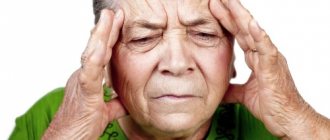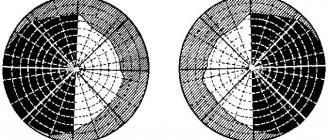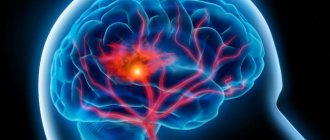To mental disorders accompanied by familiar symptoms: loss of memory, reason, impaired thinking, speech, etc. include various types of dementia. Among them is vascular dementia, ICD code 10; this pathology differs in its cause and development characteristics.
All types of mental disorders in which mental functions are impaired: memory, reason, etc. represent dementia. When cerebral vascular disorders are associated with intellectual dysfunctions that accompany human behavior, a vascular type of dementia occurs. The symptoms manifest themselves in a variety of ways; the diagnosis is established by analyzing the location of the brain damage and the nature of the course of the pathology. To accurately determine the causes of the disease, a thorough examination of the condition is required, to study the anamnesis, the degree of neuropsychological and neurological disorders.
Vascular dementia involves a type of dementia that is most common in older people
How to identify a problem by symptoms
Dementia of the vascular type can be identified by certain signs.
- In contrast to the primary, degenerative type of dementia, in the condition we describe, from 10 to 30% of cases there are seizures of epilepsy.
- Focal lesions cause impairment of motor functions, which is the primary sign of vascular dementia. Approximately from 27 to 100% of those suffering from the disease cannot walk normally, their movements are inhibited, their steps are shuffling, a loss of stability occurs, as a result of which patients often fall, hit corners, jambs, etc.
- Problems with urination. Almost all patients with the vascular type of dementia suffer from frequent urination and are forced to visit the toilet every 10-15 minutes. There is also a factor of urinary incontinence, which occurs more often at night.
- Disturbances in the expression of human emotions. When sick, a person reacts poorly; there are no signs of pleasure, joy, sadness, etc. on his face.
- Frequency of violations. Experts who observe the behavior of patients note that dysfunctions can be expressed either clearly or almost imperceptibly. Also, the severity of conditions may vary depending on the time of day or day.
- Senile dementia, ICD code 10, has a smooth progression pattern. If the problem is a consequence of a stroke, then cognitive processes may be restored, but will not be able to reach the level of a stroke. In such cases, a diagnosis of dementia in an elderly person is usually not carried out, since the disease develops slowly and unnoticed. Over time, some symptoms are joined by additional ones.
This disease progresses quite smoothly
ORGANIC, INCLUDING SYMPTOMATIC, MENTAL DISORDERS (F00-F09)
This block includes a number of mental disorders grouped together due to the presence of clear etiological factors, namely the cause of these disorders is brain disease, brain injury or stroke leading to cerebral dysfunction. Dysfunction can be primary (as in diseases, brain injuries and strokes that directly or selectively affect the brain) and secondary (as in systemic diseases or disorders when the brain is involved in the pathological process along with other organs and systems)
Dementia (F00-F03) is a syndrome caused by brain damage (usually chronic or progressive) in which many higher cortical functions are impaired, including memory, thinking, orientation, comprehension, numeracy, learning, language and judgment. Consciousness is not darkened. Decline in cognitive function is usually accompanied, and sometimes preceded, by deterioration in emotional control, social behavior, or motivation. This syndrome is observed in Alzheimer's disease, cerebrovascular diseases and other conditions that primarily or secondarily affect the brain.
If necessary, an additional code is used to identify the original disease.
Alzheimer's disease is a primary degenerative brain disease of unknown etiology with characteristic neuropathological and neurochemical manifestations. The disease usually begins insidiously and slowly, but progresses steadily over several years.
Vascular dementia is the result of cerebral infarction due to cerebral vascular disease, including cerebrovascular disease due to hypertension. Heart attacks are usually small, but their cumulative effect is manifested. The disease usually begins at a late age.
Includes: atherosclerotic dementia
Cases of dementia associated (or suspected to be associated) with causes other than Alzheimer's disease or cerebrovascular disease. The disease can begin at any age, but is less common in old age.
Presenile:
- dementia NOS
- psychosis NOS
Primary degenerative dementia NOS
Senile:
- dementia: NOS
- depressive or paranoid type
If necessary to indicate senile dementia with delirium or acute confusion, use an additional code.
Excludes: old age NOS (R54)
A syndrome characterized by a marked deterioration of memory for recent and ancient events, with preservation of the ability to immediate memories, a decrease in the ability to learn new material, and a disturbance in time orientation. Confabulation may be a feature, but perception and other cognitive functions, including intelligence, are usually preserved. The prognosis depends on the course of the underlying disease.
Korsakov psychosis, or syndrome, non-alcoholic
Excluded:
- amnesia: NOS (R41.3)
- anterograde (R41.1)
- dissociative (F44.0)
- retrograde (R41.2)
- alcoholic or unspecified (F10.6)
An environmentally nonspecific organic cerebral syndrome, characterized by simultaneous disturbances of consciousness and attention, perception, thinking, memory, psychomotor behavior, emotions, sleep-wake cycles. The duration of the condition varies and the severity ranges from moderate to very severe.
Included: acute or subacute:
- brain syndrome
- state of confusion (non-alcohol etiology)
- infectious psychosis
- organic reaction
- psychoorganic syndrome
Excludes: delirium tremens, alcoholic or unspecified (F10.4)
This category includes mixed conditions that are causally related to brain disorders due to a primary brain disease, a systemic disease secondary to the brain, exposure to exogenous toxic substances or hormones, endocrine disorders, or other physical diseases.
Excluded:
- associated with: delirium (F05.-)
- dementia classified under F00-F03
Changes in personality and behavior may be residual effects or comorbidities of brain disease, damage, and dysfunction.
Psychosis:
- organic NOS
- symptomatic NOS
Vascular dementia ICD 10: causes
Factors influencing the development of senile dementia are the following:
- head injury;
- development of neoplasms in the brain;
- past infectious diseases: encephalitis, meningitis, etc.;
- heart attacks, cerebral strokes;
- previous operations;
- diseases of the endocrine system;
- alcohol and drug abuse;
- excessive use of drugs.
Worth seeing: Vascular dementia: how long do people live with this diagnosis?
All of these factors, as well as others that influence the development of cerebral dysfunction, can lead to irreversible processes. Experts also consider genetic predisposition to be one of the main reasons.
Important: if older family members - parents, grandparents - exhibit characteristic symptoms of dementia, it is necessary to take preventive measures to minimize risks.
Development mechanism
The disease has a rather complex development mechanism. The first changes in the structure of the brain occur long before the onset of dementia. As a rule, the hypothalamus is the first to be affected. Due to the naturally occurring involution, it decreases in size, and the hypothalamus is also involved in the process. Being an organ that regulates endocrine organs and metabolic processes, hormonal disruptions occur in the body. Signs of damage to the hypothalamus are short temper and sudden changes in mood.
The reduced size of the pituitary gland is not able to fully perform its functions, which is why other parts of the nervous system, especially the cortex and subcortical structures, become vulnerable.
Neurons gradually atrophy and die. Depending on which department they are located in, the symptoms change. The convolutions become pointed, the furrows expand. Due to the loss of a large number of neurons, the cavity of the ventricles expands and their walls become thinner. At this stage, many skills are lost, and complete or partial memory loss is possible.
The loss of neurons leads to a pronounced shrinkage of the brain. Senile dementia is characterized by a symmetrical decrease in its volume.
Nerve processes and neurons are prone to sclerosis after death. This is expressed in the appearance of coarse connective tissue in the lesion. Merging with each other, they form rounded foci of necrosis - senile drusen. Strands - threads - extend from them, and in the middle the lesions are filled with a brown homogeneous mass.
Signs of vascular dementia
According to the classification, the ICD identifies the following criteria:
- Memory problems. The patient is not able to perceive information or reproduce what has already been learned.
- Inability to think logically, set problems, solve them, plan and organize actions.
- Emotional and motivational disorders. With dementia, unreasonable aggression, apathy, irritability, and strange behavior occur.
First of all, memory problems begin
General characteristics of the disease
Dementia or dementia is one of the types of cognitive mental disorders associated with the cognitive sphere of a person. Depending on the severity of dementia symptoms, the disease can be mild, moderate or severe.
With a mild degree of dementia, only the patient’s professional qualities deteriorate and his social activity decreases. A symptom of moderate dementia is loss of ability to use most household objects. At the stage of severe dementia, a person is completely maladapted and dependent on others. He is not able to independently cope with the simplest problems of hygiene or food intake.
Depending on the cause of dementia, there are two main types of disease: senile dementia (also known as senile dementia) or vascular dementia.
Unfavorable factors
Some of the triggers for the development of dementia include the following:
Floor . After extensive research, experts say that the majority of people suffering from dementia are women. There is a hypothesis that the problem is caused by a lack of the female hormone - estrogen, which ceases to be produced after menopause. However, the vascular type of dementia affects the male body more, since it is the stronger half of humanity that more often suffers from diseases associated with blood vessels and the heart.
Age . Dementia is one of the main signs of old age. It is in old age that the likelihood of developing the disease is high. The disorders occur mainly between the ages of 70 and 80, affecting approximately 20% of the total number of people.
Genetics . Heredity matters if parents developed senile dementia before old age. In cases where the disease arose after 60 years of age, the risk of inheriting the disease is reduced significantly.
Prevention of senile dementia
Considering the fact that the disease cannot be cured, you need to think about preventing it in advance. It all starts from a young age, depends on how a person lived his life. In fact, you can avoid insanity, the main thing is to follow banal but very useful recommendations.
Healthy eating. Eliminate fatty, spicy fried and smoked foods from your diet. Lean more on fresh vegetables, fruits, steamed dishes, baked in the oven.
Important: you are strictly prohibited from drinking alcohol, smoking, or consuming drugs.
- Drink plenty of fluids. Water is the main supplier of oxygen to cells. If there is a lack of fluid, the functioning of the entire body is disrupted, interruptions occur in the heart, blood vessels, kidneys, liver, etc.
- Activity. Physical inactivity is a human enemy; it creates a condition in which all processes slow down, metabolism slows down, and the brain does not receive enough oxygen, which causes cell death.
None of us are immune from diseases associated with old age. The behavior of a person with dementia causes irritation and distress. In any case, you need to be patient and perceive the problem as a fact. No matter how difficult it is, you need to honorably fulfill your duty to your parents and try to alleviate their condition.
psycholekar.ru
Dementia code according to ICD 10: how to treat
If a person exhibits the symptoms described above, medical intervention is necessary. At the initial stage, the disease can be controlled and the development of exacerbation can be prevented using techniques that activate the patient’s mental and physical activity. When diagnosing, an experienced specialist examines the functioning of the thyroid gland, brain, and conducts special testing.
Vascular dementia is treated at home, but under the supervision of a doctor
Medications and psychosocial interventions are used as treatment. The list of medications includes antidepressants, sedatives, antipsychotics, nootropics that promote blood circulation and reduce the acute phases of attacks.
Worth seeing: Vascular dementia
With psychosocial influence, the emphasis is on care and guardianship of the sick person by his relatives and friends.
Important: doctors do not recommend placing a patient with ICD dementia in a special institution. The saying “Houses and walls heal” comes into play here. In an unfamiliar, official environment, exacerbations are possible, dementia progresses, the condition is accompanied by aggression or complete apathy.
Stages of development
There are three stages of disease development:
- Mild Difficulties in perceiving new information and reproducing old information, speech becomes monotonous and boring.
- Moderate At this stage, all knowledge and skills that have been acquired are erased. Fragments of old information are lost in the flow of new information, and the patient does not notice his forgetfulness. To prevent the process of degradation from accelerating, a person must be involved in all socially useful actions.
- Severe (implies complete insanity of the patient) The person cannot cook dinner, brush his teeth, or wash himself. Any elementary action turns into a disaster.
It is impossible to say exactly how long the severe stage of senile dementia lasts: the patient’s lifespan depends on the individual condition of the patient and the characteristics of his body.
It is often accompanied by neurological changes that reflect the essence of the disease:
- tremor of the limbs,
- motor impairment,
- akathisia.
It is worth noting that the last phase of dementia is the most rapid, usually after its onset a person lives no more than a year.
The video will tell you more about this stage of the patient’s life and how to help him:
At all stages of the disease, the patient needs care; hysterical forms of dementia, or pseudodementia, are precisely the reason for the lack of attention from loved ones.
Sooner or later, you have to resort to the help of professional nurses and emergency doctors; attacks of diseases that lead to dementia become more frequent at a later stage.
Find out more: what to do for loved ones of a person suffering from senile dementia, what is the treatment of the disease, what drugs are used to treat the disease.
The risk of stroke and sugar levels are monitored; if both diabetes and stroke have occurred, the patient is admitted to a hospital; unfortunately, doctors are increasingly prescribing bed rest for such patients at home.
The speed of transition from stage to stage depends on lifestyle and care.
It is impossible to avoid senile dementia, even if close relatives have not been diagnosed with it, and there are no people in the family who have been exposed to this disease.
There is a risk of developing side symptoms and signs that do not go beyond the norm and are considered standard character and behavioral disorders.
Quarrelsomeness, pickiness and greed, worsened in older age, are just such signs.
More complex types of presenile and senile forms of the disease also often go unnoticed by the neurologist, since the person does not notice forgetfulness, distracted attention and increased fatigue.
As a result, he comes to the doctor while in the middle stage of degradation.
Preventing dementia means being active, socially interacting with others, and paying attention to your health from an early age.
Description
Alzheimer's disease is a disease of the nervous system characterized by degenerative processes in the nervous tissue and the gradual loss of cognitive skills. The disease is named after the German doctor who first described specific intellectual-mnestic disorders in this disease back in 1907. After 65 years, the risk of developing this disease increases sharply, but more often it manifests itself at the age of 40-50 years, and the earliest onset recorded in the history of medicine is 28 years.
Types of disease
Each type of senile dementia has its own code in ICD-10.
For Alzheimer's disease . The disease has neuropathological features and progresses over the years. The onset of the disease is 50–65 years .
Neurotic character traits become aggravated, anxiety and fear for oneself and loved ones come to the fore, poor memory aggravates the anxious state.
It is difficult for a person to express his thoughts. Over time, the help of a social worker is required. The pathological condition is dealt with by a neurologist and a psychiatrist.
Basic drugs with cholinesterase inhibitors that correct the patient’s well-being:
Treatment with folk remedies:
Vascular dementia . The consequence of hypertension is damage to the blood vessels of the brain. Makes itself felt in old age.
Brain neurons die from insufficient blood supply, the cause is atherosclerosis and coronary heart disease. The attending physician is a neurologist.
Prescribed
drugs :
As additional methods of treatment, you can resort to traditional medicine :
Concomitant diseases : arterial hypertension, concussions, stroke.
Pick's disease . A type of senile dementia with lesions in areas of the brain located in the frontal lobes.
It manifests itself in the same way: antisocial behavior, disinhibition of instincts, loss of cognitive abilities.
Treatment: neuroleptics and anticholinesterase agents.
For Creutzfeldt-Jakob disease . Genetic and viral pathology causes mutation of a healthy protein.
The pathogenic prion protein accumulates in the body, destroying healthy brain cells (there are no cells suitable for the development of the virus in other tissues).
Cases of infection have been reported from eating beef.
Signs of pathology remain unnoticed until old age . It is after 55 years that the degenerative properties of tissues allow the protein to develop in the human body.
For Huntington's disease .
A hereditary disease caused by degeneration of gamma-aminobutyric acid. A hallmark of this type of dementia is the presence of hallucinations and antisocial behavior. The disease is transmitted by a dominant type.
This type of dementia is difficult to distinguish from other types; the only symptom, a marker of the disease, is hyperkinesia.
For Parkinson's disease . Parkinson's disease is a debilitating neurological condition that causes dementia.
A lack of dopamine in the brain and insufficient transmission of dopamine to nerve endings make it difficult to move smoothly and make speech poor.
Protein deposits in the brain replace healthy tissue, blocking dopamine receptors, resulting in akathisia and tremors.
For an illness caused by the human immunodeficiency virus [HIV] (B22.0+) . HIV dementia is a complex of symptoms caused by microorganisms that do not develop if a strong immune system is present.
The severity of this type of dementia in older people is practically not observed - this is a special form of HIV infection.
Unspecified (NOS “not otherwise specified”) . Senile dementia with no symptoms.
The illness is on the verge of psychology/psychiatry and is often hysterical in nature. Common name: senile sclerosis.
Senile and presenile dementia
Presenile dementia occurs at early retirement age.
Alzheimer's disease is an indicative type of presenile dementia. A person ceases to understand the speech of others, and difficulty reading newspapers arises. The patient lets himself go.
Habits from a past life are forgotten, hygiene and comfort fade into the background.
Life activity decreases, by the age of 60–65 a person stops moving and slowly dies.
Alzheimer's type
Classic dementia of the Alzheimer's type is quite severe. It is diagnosed after 65 years , most likely, this is the middle - late stage of the disease.
The patient cannot distinguish complex phrases spoken to him at moderate volume. The sounds of speech perceived from the outside turn into cacophony. Rigidity of character is due to the restructuring of the brain to a simplified mode.
There is no place for hobbies and friends in a person’s life; all the time he is focused on himself and his experiences. Amnestic dementia syndrome, as a marker of the disease, occurs at a late stage of the disease.
Characterized by the inability to remember any dates or numbers.
At this stage the person becomes incapacitated . Mnestic-intellectual functions disintegrate, a person completely loses the concept of time and space. The rhythm of wakefulness is disturbed, night sleep is superficial.
The prognosis of the disease is disappointing, leading to complete maladaptation and disability . The drugs relieve only neurological symptoms, such as high blood pressure and tremors.











